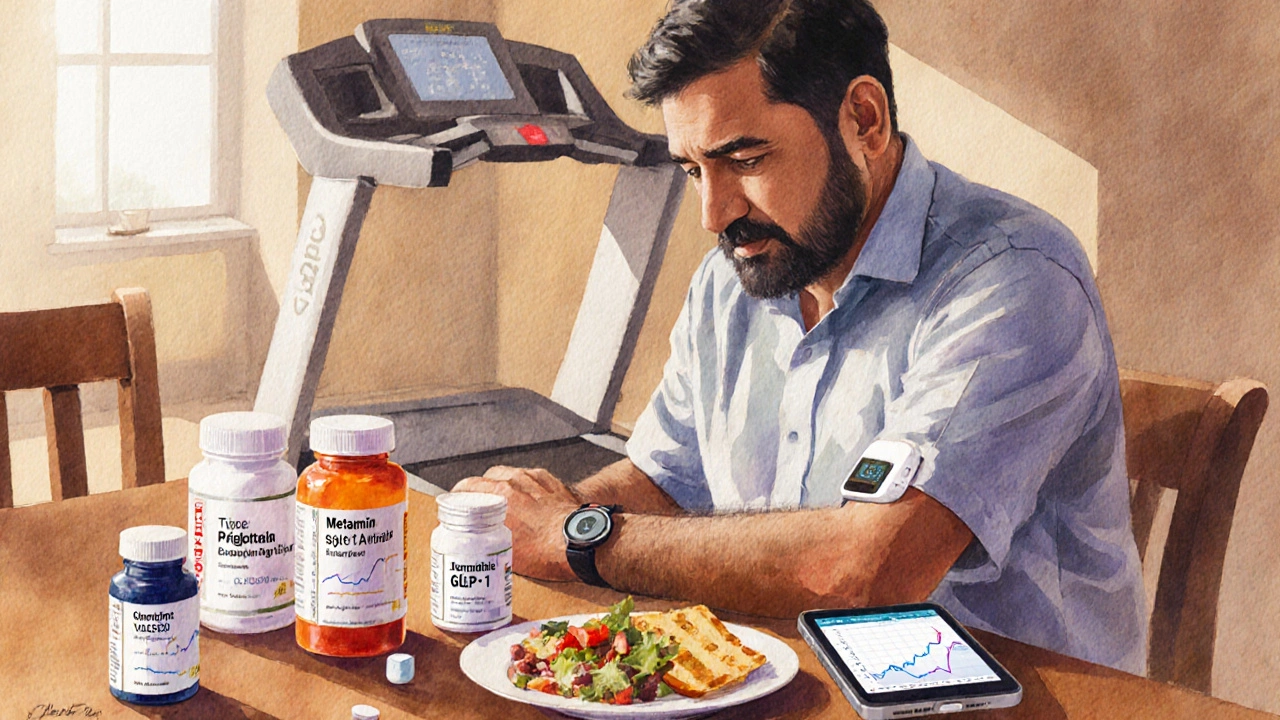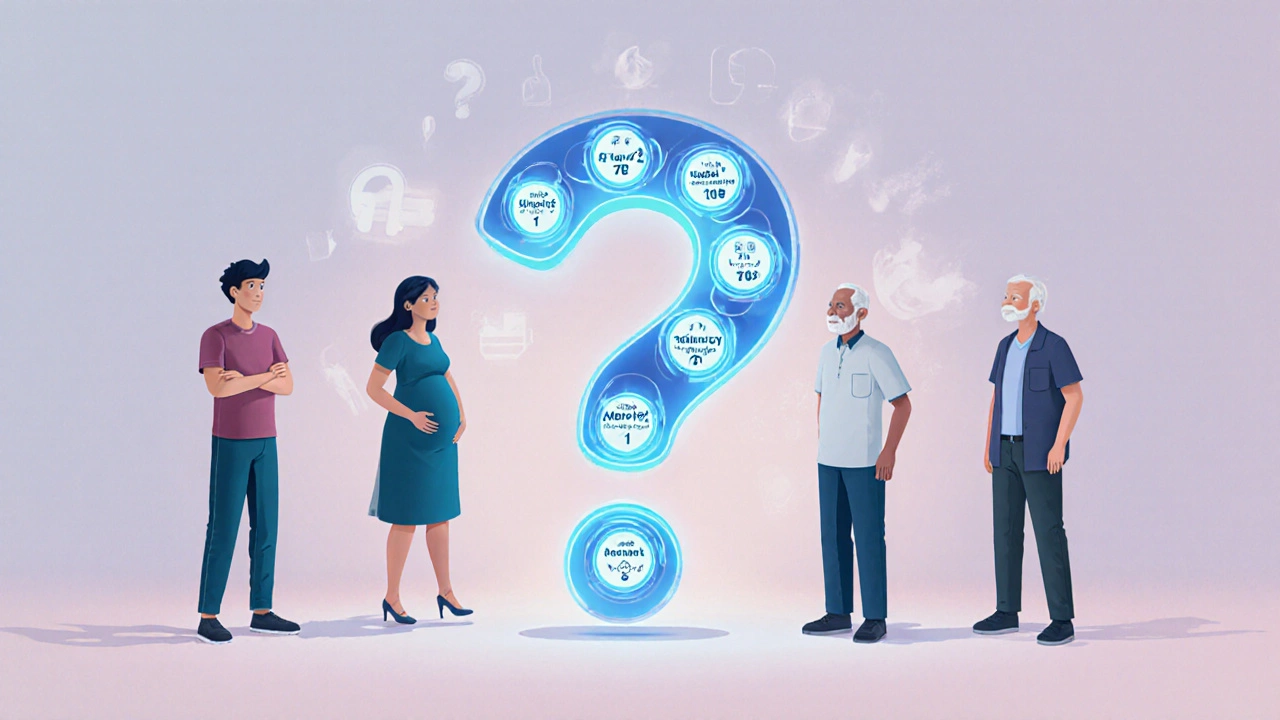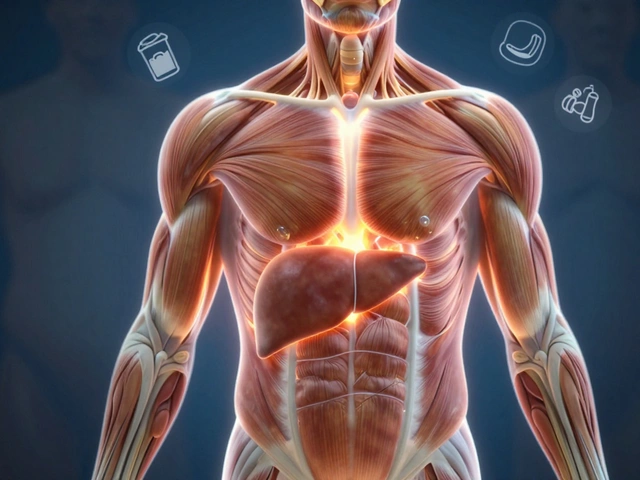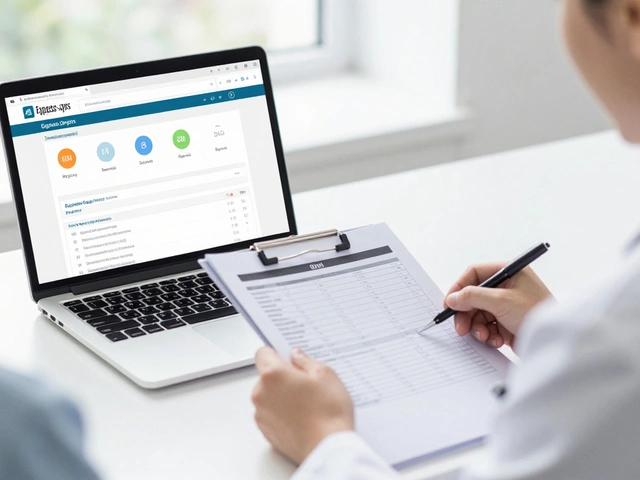Diabetes Control Difficulty Assessment Tool
Control Difficulty Calculator
Select your diabetes type and characteristics to see how difficult control might be based on multiple factors.
Control Difficulty Score
How to interpret your score
0-30: Easy to manage with proper care
31-60: Moderate control difficulty
61-100: Significant challenges in management
Your Control Difficulty Assessment
Control Tips for Your Diabetes Type
When you hear people ask, “Which diabetes is hardest to control?” the answer isn’t a simple yes‑or‑no. The difficulty flips between the type of diabetes, how the body reacts, the medicines you’re on, and daily habits. Below we break it all down so you can see why one type often gives more headaches than another.
Key Takeaways
- Type2 diabetes is generally the hardest to keep under control because of progressive insulin resistance and the need for multiple drugs.
- Type1 diabetes demands precise insulin dosing, making short‑term control tricky, but the treatment path is clearer.
- Gestational and monogenic diabetes are usually easier to manage when diagnosed early.
- Advanced tools - continuous glucose monitors (CGM) and modern drug classes - can level the playing field.
- Regular check‑ins with an endocrinologist help catch control issues before they spiral.
Diabetes mellitus is a chronic condition where the body either doesn’t make enough insulin or can’t use it effectively, leading to high blood sugar (glucose) levels. The disease comes in several forms, each with its own set of challenges for patients and doctors.
Understanding the Main Types of Diabetes
Before we label one type as “hardest,” let’s clarify what we’re dealing with.
Type 1 diabetes is an autoimmune disorder that destroys the insulin‑producing beta cells in the pancreas. People with type1 need lifelong insulin injections or pump therapy.
Type 2 diabetes starts with insulin resistance - the body’s cells ignore insulin - and often progresses to reduced insulin production over time. Lifestyle, genetics, and age all play a role.
Gestational diabetes appears during pregnancy and usually resolves after birth, though it raises future diabetes risk for both mother and child.
Other, less common forms include monogenic diabetes (single‑gene mutations) and secondary diabetes caused by drugs or other diseases.
What Makes a Diabetes Type Hard to Control?
Control difficulty isn’t just about the label; it’s about how the body reacts and which tools are available. The main factors include:
- Insulin dynamics: Whether the body makes any insulin at all, and how quickly it can be delivered.
- Insulin resistance: Cells that ignore insulin need higher doses, increasing the chance of side effects.
- Medication complexity: Some types need multiple oral drugs, injectables, and perhaps newer agents like GLP‑1 agonists.
- Lifestyle impact: Diet, exercise, stress, and sleep influence blood sugar swings dramatically.
- Glycemic variability: Frequent highs and lows make it harder to maintain a stable HbA1c (average blood glucose over three months).
- Technology access: Continuous glucose monitors (CGM) and insulin pumps can tighten control but are not always affordable.
Why Type2 Diabetes Often Tops the “Hardest to Control” List
Even though type2 starts out with the body still producing insulin, the combination of insulin resistance and a gradual decline in beta‑cell function creates a moving target.
Key reasons:
- Progressive resistance: Over years, cells become less responsive, meaning doses must keep rising. This can lead to weight gain and higher cardiovascular risk.
- Multiple drug regimens: Most patients start with Metformin (a first‑line oral agent), then add sulfonylureas, SGLT2 inhibitors, or GLP‑1 receptor agonists. Managing side‑effects from several pills can be overwhelming.
- Lifestyle dependence: Diet and exercise are central, but adherence drops for many, especially when weight loss is slow.
- Hidden hypoglycemia: Some newer drugs (e.g., insulin, sulfonylureas) cause low blood sugar without obvious symptoms, leading patients to under‑dose and raise their average glucose.
- Comorbidities: Hypertension, dyslipidemia, and obesity frequently co‑exist, adding medication burden and complicating glucose targets.
Because of these layers, type2 patients often see their hardest diabetes to control status shift as the disease progresses.

Control Challenges in Type1 Diabetes
Type1 is an “all‑or‑nothing” scenario - you need insulin 24/7. The challenge isn’t the lack of insulin production (that’s a given) but getting the dose right every single moment.
- Precision dosing: Carbohydrate counting, activity‑based adjustments, and stress hormones all swing insulin needs minute‑by‑minute.
- Risk of hypoglycemia: Too much insulin drops glucose dangerously low, especially at night.
- Technology reliance: Insulin pumps and CGMs help, but technical glitches or sensor errors can cause sudden spikes.
While day‑to‑day swings are tough, the clear treatment pathway (insulin) means that once a patient masters the dosing routine, long‑term control can be stable - unlike the evolving medication maze of type2.
Gestational and Other Rare Forms
Gestational diabetes usually appears in the second trimester and often resolves after delivery, making short‑term control manageable with diet, sometimes metformin, and occasional insulin.
Monogenic diabetes (e.g., MODY) responds well to specific drugs, sometimes even just sulfonylureas, and doesn’t involve the progressive resistance seen in type2.
Because of the limited duration and targeted treatment, these forms are rarely labeled as “hardest to control.”
Side‑by‑Side Comparison of Control Difficulty
| Diabetes Type | Main Control Barrier | Typical Medication Load | Technology Needed? | Long‑Term Outlook |
|---|---|---|---|---|
| Type 1 | Precise insulin dosing & hypoglycemia risk | Insulin only (multiple daily injections or pump) | CGM &/or pump highly beneficial | Stable if dosing mastered; risk of complications if not |
| Type 2 | Progressive insulin resistance + lifestyle factors | Metformin + 1‑3 additional oral agents ± basal insulin | CGM helpful; pump rarely needed | Control often wanes over years; may need insulin later |
| Gestational | Rapid hormonal changes during pregnancy | Diet first, then metformin or short‑acting insulin | Glucose meters usually sufficient | Usually resolves postpartum; future risk elevated |
| Monogenic (MODY) | Genetic mutation‑specific response | Often a single sulfonylurea; rarely insulin | Standard glucose monitoring | Excellent control possible with right drug |

Practical Strategies to Tame the Hardest Type (Usually Type2)
- Early aggressive lifestyle change: Even a 5‑10% weight loss can improve insulin sensitivity dramatically.
- Optimize oral therapy: Start with metformin, add an SGLT2 inhibitor (cardio‑renal benefits) before moving to GLP‑1 agonists for weight loss.
- Consider early basal insulin: Low‑dose basal insulin can smooth out fasting glucose and reduce the need for multiple oral agents.
- Use technology wisely: A CGM provides real‑time trends, helping you adjust meals and activity before highs become highs.
- Regular lab monitoring: Keep HbA1c under 7% (or your doctor’s target) and review kidney and eye health every 6‑12 months.
- Team‑based care: Involve a dietitian, diabetes educator, and possibly a mental‑health professional to address burnout.
When Control Feels Out of Reach - Seek Specialist Help
If your average glucose stays above target despite following the steps above, it’s time for an endocrinology consult. Look for these red flags:
- HbA1c > 9% for more than six months
- Frequent hypoglycemia episodes (blood sugar <70mg/dL)
- Rapid weight gain or unexplained swelling
- New pain, vision changes, or nerve symptoms
Specialists can add newer options like dual‑GIP/GLP‑1 agonists, assess for bariatric surgery eligibility, or fine‑tune insulin pump settings.
Bottom Line
While type1 demands strict insulin precision, the evolving resistance and medication maze of type2 generally makes it the hardest diabetes to control for most adults. Early lifestyle action, smart drug choices, and tech tools can flatten the curve, but ongoing partnership with a healthcare team is the safety net you need.
Frequently Asked Questions
Which diabetes type is hardest to control?
For most adults, type2 diabetes is the hardest to control because insulin resistance worsens over time and patients often need several oral drugs plus lifestyle changes.
Why does type2 diabetes become harder to manage with age?
Beta‑cell function naturally declines with age, and long‑standing insulin resistance forces the pancreas to work harder, leading to higher glucose levels that require higher medication doses.
Can a continuous glucose monitor help with type2?
Yes. CGMs show real‑time trends, allowing quick adjustments in diet, activity, or medication before glucose spikes become severe.
What is the first‑line drug for type2 diabetes?
Metformin is the standard first‑line medication because it lowers glucose, is inexpensive, and has a good safety profile.
Is gestational diabetes permanent?
Usually it disappears after childbirth, but it raises the mother’s risk of developing type2 diabetes later in life.









